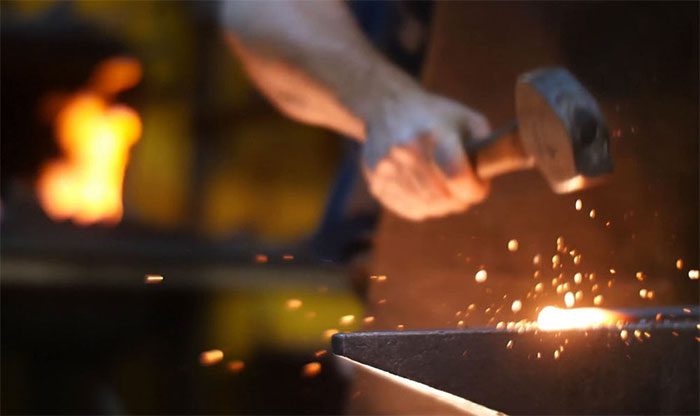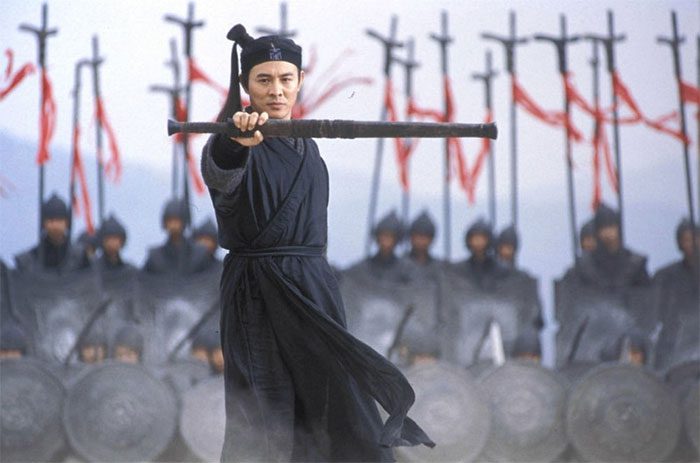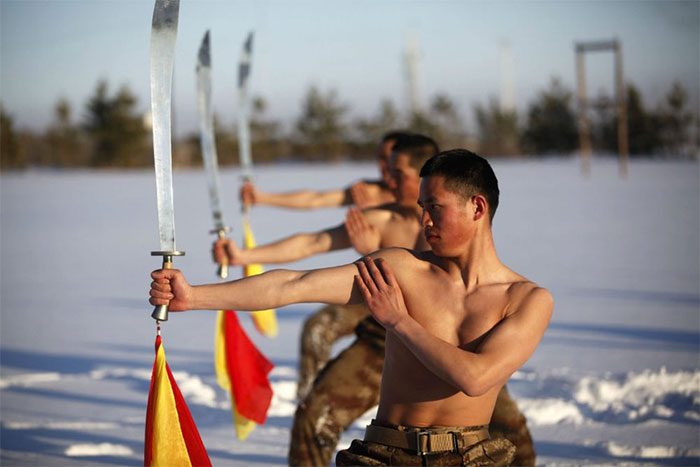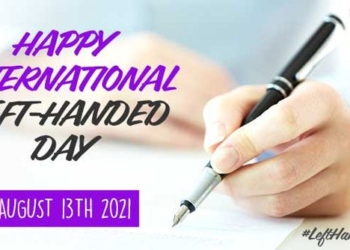In the history of East Asia, the sword has transcended its role as a mere weapon; it has sometimes become a being, a sacred entity, especially when used to harm others. For this reason, the sword is often regarded as a companion of the swordsman, a partner rather than a lifeless weapon. The process of sword forging is not merely a technique but is also seen as a ritual.
Types of Swords: Tapered and Broad

According to archaeological findings, over 2000 years ago, the Chinese created exquisite tools.
According to legend, swords originated during the Zhou Dynasty in China and reached their peak during the Spring and Autumn and Warring States periods. This was a time when the Chinese had just discovered iron, coupled with new techniques in metallurgy, leading to tools that were stronger than bronze. Consequently, many swords forged during the Spring and Autumn and Warring States periods are referred to as treasured swords. The sword was not only a personal weapon but also a form of adornment, worn by heroes and scholars to enhance their prestige.
During this period, swords were shorter than those that came later. It is believed that due to swords being made of bronze and the limited metallurgical techniques available, longer swords were prone to breaking or bending. Only later, when swords began to be forged from steel, did the blades become thinner and longer, although Chinese swords were not as long and curved as Japanese swords. The bronze swords of that era had short blades similar to daggers, with short hilts that were not designed for handling but rather for wearing at the waist. Gradually, by the end of the bronze age, hilts evolved to be more functional. Hilts often featured grooves for easier handling and to prevent slipping. As time progressed, both the blades and hilts grew longer and thicker, and there were innovations that separated the hilt from the blade. Hilts were typically made of wood or horn and sometimes adorned with gold, silver, jade, or intricate carvings.
In later periods, the standard length for swords was established at 70 to 85 cm. Swords were categorized as tapered (thư) and broad (hùng). Broad swords were longer and larger than tapered swords. Scabbards were often forged from bronze or made of leather.
Chinese bronze is an alloy consisting of copper, zinc, and lead. Occasionally, they would also mix in gold and silver. Each dynasty, from the Shang Dynasty (16th-11th century BC) to the Western Zhou (11th-8th century BC) and the Spring and Autumn period (770-476 BC), developed different methods. By the end of the Warring States period, as they transitioned to the Iron Age, they had accumulated thousands of years of experience in bronze casting, applying those techniques to iron casting. The discovery of new, harder metals led them to strive for sharper weapons. Since iron is tougher and more elastic than bronze, steel swords could be forged longer.
Five Stages of Sword Forging

Swords originated during the Zhou Dynasty in China and peaked during the Spring and Autumn and Warring States periods.
The techniques became increasingly complex. The book “Heavenly Craft and Material Creation” from the Ming Dynasty categorizes many methods and techniques in forging copper and iron, including casting tops, bells, hammers, statues, guns, glass, and coins.
According to historical texts, the traditional Chinese forging method typically passes through five stages.
1. Shaping the model
2. Using the model to create the mold
3. Melting the alloy and pouring it into the mold
4. Waiting for the metal to solidify and removing it from the mold
5. Carving or refining the exterior
Commonly mixed alloys include iron, copper, tin, gold, and silver. According to modern documentation, steel is iron that contains 0.1 – 1.8% carbon; under 0.06% is soft iron, easily wrought but not hard or elastic, while over 1.8% is cast iron, which is hard but brittle and prone to breaking. In Europe, the Iron Age began around 1300 BC, but in China, iron only became prevalent around the 7th century BC. If iron contains little carbon (iron and steel), it can be heated until red and then hammered into shape. If it contains more carbon (cast iron), it must be melted into a liquid form for casting.
Archaeologists believe that before reaching the stage of cast iron, humanity had to go through the phase of wrought iron (heating and hammering into shape). According to excavations from the Warring States period, they had not yet cast iron, only reaching the stage of wrought iron. However, some excavations of iron artifacts have led to the conclusion that iron casting might have occurred earlier, inheriting techniques from bronze casting and ceramics, while the wrought iron technique developed later. Many scholars argue that both techniques evolved concurrently, rather than one being the precursor to the other.
During the Han Dynasty, the Chinese invented the double bellows, which allowed for continuous fanning and thus higher temperatures than the bellows from the Warring States period. They also learned to mix different metals to increase the hardness and ductility of the materials. They mined ores, enabling greater production, and learned to weld together hard and soft steel to create blades or various weapons, although many scholars believe this innovation may have originated from Central Asia and spread to both East and West.

The sword is sometimes regarded as a personal possession of the swordsman, a companion rather than a lifeless weapon.
The use of molds to cast various tools and weapons, along with the forging of steel, made iron more common, and steel weapons surpassed those made of bronze. Meanwhile, it wasn’t until the Middle Ages that Europeans learned to cast iron, and steel production lagged significantly behind.
How to Make Steel Hard and Durable?
The method of forging iron involves heating an iron block and then hammering it into the desired shape. Historical records indicate that as early as pre-Christian times, the Chinese had discovered ways to create blades that were very hard yet durable enough not to break during combat. The process of mixing iron and carbon, as well as adjusting temperatures for forging swords, is an extremely complex art.
All metals are made up of interlocking crystals, and the arrangement of these crystals affects the metal’s properties. If over-forged, while iron may become harder, it can also become brittle, similar to bending a steel wire back and forth repeatedly. Therefore, in sword forging, the craftsman must carefully measure the forging process, not forging too little (resulting in insufficient hardness) or too long (resulting in brittleness). There is also a method called “quenching,” which involves using soft steel combined with hardened steel to create a tool that is hard yet ductile.
Many scholars also believe that the Chinese were the first to learn how to extract carbon from cast iron to produce steel. By the 2nd century BC at the latest, they understood this principle, which later influenced Western metallurgy in the 19th century. The removal of carbon from steel and cast iron has been applied to produce soft iron used in bridge construction and pipe casting.
They utilized a method of blowing air through molten iron known as hundredfold refining. The second method used for metallurgy involved mixing soft iron and cast iron to create steel, which they had been practicing since the 5th century AD. Recently, at a steel workshop in Corby, England, experiments were conducted and proven successful.
Later, beyond conventional methods, three relatively sophisticated methods were employed to create a quality sword. The most common method is that after forging, the weapon is heated to a low temperature and then cooled slowly. Those skilled can determine the craftsmanship of the swordsmith just by observing the steel’s surface and the structure of the blade.

Chinese soldiers practicing sword fighting.
Another method is to forge a sword with a core of soft iron, while the outer layer is hardened steel. Sometimes craftsmen combine various types of steel with different hardness levels, from the tip of the blade, the blade itself, the spine near the hilt, to the grip, to fulfill the roles and functions of each part. This technique is particularly challenging and requires high skill. Achieving a thin layer on the spine while maintaining a thick, sturdy blade is a meticulous and intricate task.
Quenching iron involves immersing the metal into water or oil when it is not yet fully hardened to increase its hardness. However, it is often necessary to let the temperature drop gradually because if it cools too quickly, the steel will become hard but brittle. While sword casting methods can be imitated by others, the quenching process is kept very secret, akin to a hidden technique. The specific solution used, the temperature, and the method are all closely guarded secrets. Blacksmiths rarely allow anyone to observe how they quench steel, and curiosity about this process is a taboo, especially among Japanese blacksmiths.
At the end of the Warring States period, the Chinese developed mining techniques, combining bronze and iron casting with increasingly sophisticated weaponry. Many foundries employed over 200 workers, and many individuals in this industry became quite wealthy, playing a significant role in society. Archaeological evidence suggests that over 2000 years ago, the Chinese were producing intricate tools that could be considered the finest in the world.
Why did the Chinese master iron casting so early? Several factors have been hypothesized to explain this development.
First, the country had high-quality clay suitable for constructing the walls of smelting furnaces.
Second, they knew how to lower the melting point of iron ore, making the casting process more convenient. The advancements in metallurgy led to improvements in agriculture, with the widespread use of plows and the invention of various other agricultural tools.
|
China is also credited with elevating iron casting to an industrial level, meaning they invested considerable effort into establishing large-scale operations while centralizing this work under the imperial government and setting standards for various iron products. This large-scale production significantly contributed to economic development as well as military capabilities. During the Han Dynasty, the government monopolized the production and distribution of two key commodities: iron and salt, in addition to taxes imposed on agricultural products to finance the administrative and military apparatus. By the 2nd century BC, there were at least 46 state-owned iron foundries throughout China, and remnants of ore weighing up to 25-30 tons had been discovered, a weight that Europe would only achieve by the 18th century. Weapons, plows, sickles, and other tools were produced to certain standards. They also manufactured steel plow blades attached to wooden handles and developed machines that could drill holes and sow seeds, eliminating the need for manual planting—a technique later adopted by Europe. The method of blowing hot air through molten steel to refine metals was a complex technique used by the Chinese 20 centuries ago, similar to the metallurgical furnaces of Henry Bessemer in the 19th century. |
|
In our country, the legend of sacred swords is seldom mentioned. The sacred swords in Vietnamese history primarily refer to their legal value, symbolizing a dynasty or authority, rather than their sharpness. The “Thượng Phương” sacred sword was a sword that the king would often bestow upon high-ranking officials, granting them the authority to execute first and report to the king afterward (a delegation of unlimited authority), particularly when leading troops to quell rebellion. The swords of the Nguyen dynasty featured jeweled hilts, steel blades, and scabbards engraved with “Khải Định niên chế” and “Trọng Kim Tứ Lạng Thất Ngũ Phân” (weight of 4 taels, 7 candareens, and 5 fen). This sword, along with the imperial seal of the Nguyen dynasty, was handed over to the Viet Minh government in 1945 when Emperor Bao Dai abdicated. Our swords are also different from those of China. While Chinese swords are double-edged, Vietnamese swords resemble long knives, with one side as the blade, the other as the back, slightly curved at the tip, and are commonly referred to as gươm or quất. Gươm are primarily used for slashing, while swords are used for stabbing. When wielding a single sword, it is called a single sword (đơn kiếm), and when using two swords with both hands, it is referred to as twin swords (song kiếm). |




















































